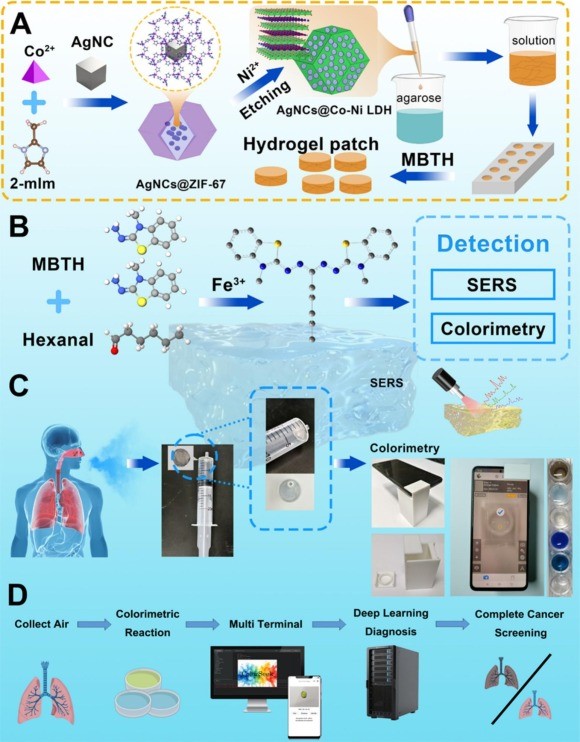
Recently, a research team led by Prof. HUANG Qing from the Institute of Intelligent Machines, the Hefei Institutes of Physical Science of the Chinese Academy of Sciences, successfully developed a dual-mode flexible hydrogel sensor integrating both surface-enhanced Raman scattering (SERS) and colorimetric detection approaches. This sensor can achieve ultra-sensitive detection of hexanal, a volatile organic compound (VOC) biomarker for lung cancer, providing a new solution for early non-invasive screening of lung cancer.
The paper has been published in Chemical Engineering Journal.
Early diagnosis of lung cancer is crucial for curing, while existing methods have limitations such as complicated operation of equipments and high costs. Breathomics, which analyzes VOCs in exhaled breath, offers a new path for non-invasive screening. Among these, hexanal is a potential biomarker with high specificity. However, achieving precise detection at low concentrations remains a key technical challenge.
To address this, Prof. HUANG’s research team successfully developed a dual-mode hydrogel sensor patch based on silver nanocubes coated with cobalt-nickel layered double hydroxide (AgNCs@Co-Ni LDH). This material exhibits both excellent SERS effect and adsorption capability. When fixed together with the chromogenic agent 3-methyl-2-benzothiazolinone hydrazone (MBTH) in an agarose hydrogel, contact with hexanal-containing gas triggers a specific reaction between MBTH and hexanal. This produces a visually discernible blue color for colorimetric analysis, and generating a strong SERS signal as well for dual-mode cross-verification, thus significantly improving reliability.
The sensor demonstrates outstanding performance, combining ultra-high sensitivity with a wide detection range. The hydrogel’s three-dimensional porous structure effectively stabilizes the material and promotes gas adsorption and reaction, reducing detection time to 1.5 minutes. The team also developed a supporting smartphone-based image recognition system, "ColorSeek," which utilizes a convolutional neural network (CNN) for automatic colorimetric result analysis.
Using this system, exhaled breath samples from lung cancer patients and healthy individuals can be accurately distinguished, showing high reliability and clinical potential. This research provides an innovative, non-invasive tool for early lung cancer screening and establishes a strong foundation for developing similar technologies to detect other disease biomarkers in breath.
The study was supported by the National Natural Science Foundation of China and the Special International Academic Exchange Program of Chinese Academy of Sciences.

A hydrogel sensing patch with AgNCs@Co-Ni LDH as the functional matrix is constructed to detect trace VOC gas markers through SERS and colorimetric dual-mode measurement methods, and combined with smartphones and related deep learning algorithms for non-invasive early screening of lung cancer. (Image by LI Jialin )